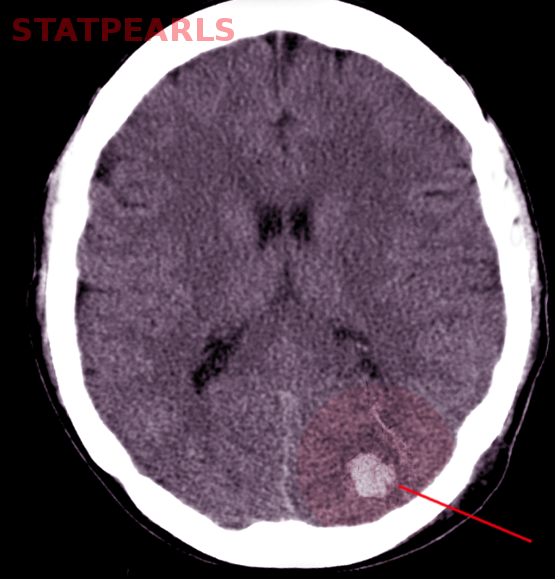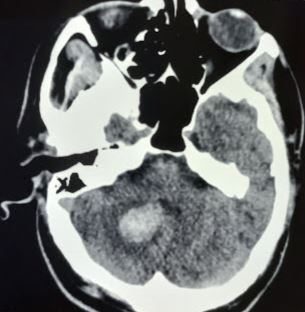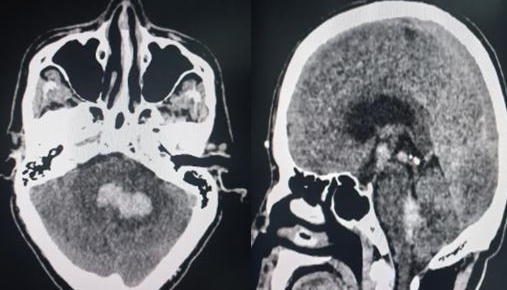[1]
Datar S, Rabinstein AA. Cerebellar hemorrhage. Neurologic clinics. 2014 Nov:32(4):993-1007. doi: 10.1016/j.ncl.2014.07.006. Epub 2014 Sep 11
[PubMed PMID: 25439293]
[2]
Itoh Y, Yamada M, Hayakawa M, Otomo E, Miyatake T. Cerebral amyloid angiopathy: a significant cause of cerebellar as well as lobar cerebral hemorrhage in the elderly. Journal of the neurological sciences. 1993 Jun:116(2):135-41
[PubMed PMID: 8336159]
[3]
Satoh K, Satomi J, Nakajima N, Matsubara S, Nagahiro S. Cerebellar hemorrhage caused by dural arteriovenous fistula: a review of five cases. Journal of neurosurgery. 2001 Mar:94(3):422-6
[PubMed PMID: 11235946]
Level 3 (low-level) evidence
[4]
Kim MS, Kim SW, Chang CH, Kim OL. Cerebellar pilocytic astrocytomas with spontaneous intratumoral hemorrhage in adult. Journal of Korean Neurosurgical Society. 2011 Jun:49(6):363-6. doi: 10.3340/jkns.2011.49.6.363. Epub 2011 Jun 30
[PubMed PMID: 21887396]
[5]
Mesiwala AH, Avellino AM, Roberts TS, Ellenbogen RG. Spontaneous cerebellar hemorrhage due to a juvenile pilocytic astrocytoma: case report and review of the literature. Pediatric neurosurgery. 2001 May:34(5):235-8
[PubMed PMID: 11423772]
Level 3 (low-level) evidence
[6]
Cordonnier C, Demchuk A, Ziai W, Anderson CS. Intracerebral haemorrhage: current approaches to acute management. Lancet (London, England). 2018 Oct 6:392(10154):1257-1268. doi: 10.1016/S0140-6736(18)31878-6. Epub
[PubMed PMID: 30319113]
[7]
Friedman JA, Piepgras DG. Remote cerebellar hemorrhage. Journal of neurosurgery. 2002 Aug:97(2):498-9; author reply 499
[PubMed PMID: 12186489]
[8]
Feigin VL, Lawes CM, Bennett DA, Barker-Collo SL, Parag V. Worldwide stroke incidence and early case fatality reported in 56 population-based studies: a systematic review. The Lancet. Neurology. 2009 Apr:8(4):355-69. doi: 10.1016/S1474-4422(09)70025-0. Epub 2009 Feb 21
[PubMed PMID: 19233729]
Level 3 (low-level) evidence
[9]
Steiner T, Al-Shahi Salman R, Ntaios G. The European Stroke Organisation (ESO) guidelines. International journal of stroke : official journal of the International Stroke Society. 2014 Oct:9(7):838-9. doi: 10.1111/ijs.12369. Epub
[PubMed PMID: 25231578]
[10]
Broderick JP, Brott T, Tomsick T, Miller R, Huster G. Intracerebral hemorrhage more than twice as common as subarachnoid hemorrhage. Journal of neurosurgery. 1993 Feb:78(2):188-91
[PubMed PMID: 8421201]
[11]
Stein M, Misselwitz B, Hamann GF, Scharbrodt W, Schummer DI, Oertel MF. Intracerebral hemorrhage in the very old: future demographic trends of an aging population. Stroke. 2012 Apr:43(4):1126-8. doi: 10.1161/STROKEAHA.111.644716. Epub 2012 Jan 26
[PubMed PMID: 22282880]
[12]
Flaherty ML, Woo D, Haverbusch M, Sekar P, Khoury J, Sauerbeck L, Moomaw CJ, Schneider A, Kissela B, Kleindorfer D, Broderick JP. Racial variations in location and risk of intracerebral hemorrhage. Stroke. 2005 May:36(5):934-7
[PubMed PMID: 15790947]
[13]
Garcia JH, Ho KL. Pathology of hypertensive arteriopathy. Neurosurgery clinics of North America. 1992 Jul:3(3):497-507
[PubMed PMID: 1633473]
[14]
Friedman JA, Piepgras DG, Duke DA, McClelland RL, Bechtle PS, Maher CO, Morita A, Perkins WJ, Parisi JE, Brown RD Jr. Remote cerebellar hemorrhage after supratentorial surgery. Neurosurgery. 2001 Dec:49(6):1327-40
[PubMed PMID: 11846932]
[15]
Gupta R, Phan CM, Leidecker C, Brady TJ, Hirsch JA, Nogueira RG, Yoo AJ. Evaluation of dual-energy CT for differentiating intracerebral hemorrhage from iodinated contrast material staining. Radiology. 2010 Oct:257(1):205-11. doi: 10.1148/radiol.10091806. Epub 2010 Aug 2
[PubMed PMID: 20679449]
[16]
Wijdicks EF, Sheth KN, Carter BS, Greer DM, Kasner SE, Kimberly WT, Schwab S, Smith EE, Tamargo RJ, Wintermark M, American Heart Association Stroke Council. Recommendations for the management of cerebral and cerebellar infarction with swelling: a statement for healthcare professionals from the American Heart Association/American Stroke Association. Stroke. 2014 Apr:45(4):1222-38. doi: 10.1161/01.str.0000441965.15164.d6. Epub 2014 Jan 30
[PubMed PMID: 24481970]
[17]
Anderson CS, Heeley E, Huang Y, Wang J, Stapf C, Delcourt C, Lindley R, Robinson T, Lavados P, Neal B, Hata J, Arima H, Parsons M, Li Y, Wang J, Heritier S, Li Q, Woodward M, Simes RJ, Davis SM, Chalmers J, INTERACT2 Investigators. Rapid blood-pressure lowering in patients with acute intracerebral hemorrhage. The New England journal of medicine. 2013 Jun 20:368(25):2355-65. doi: 10.1056/NEJMoa1214609. Epub 2013 May 29
[PubMed PMID: 23713578]
[18]
Arima H, Anderson CS, Wang JG, Huang Y, Heeley E, Neal B, Woodward M, Skulina C, Parsons MW, Peng B, Tao QL, Li YC, Jiang JD, Tai LW, Zhang JL, Xu E, Cheng Y, Morgenstern LB, Chalmers J, Intensive Blood Pressure Reduction in Acute Cerebral Haemorrhage Trial Investigators. Lower treatment blood pressure is associated with greatest reduction in hematoma growth after acute intracerebral hemorrhage. Hypertension (Dallas, Tex. : 1979). 2010 Nov:56(5):852-8. doi: 10.1161/HYPERTENSIONAHA.110.154328. Epub 2010 Sep 7
[PubMed PMID: 20823381]
[19]
Morgenstern LB, Hemphill JC 3rd, Anderson C, Becker K, Broderick JP, Connolly ES Jr, Greenberg SM, Huang JN, MacDonald RL, Messé SR, Mitchell PH, Selim M, Tamargo RJ, American Heart Association Stroke Council and Council on Cardiovascular Nursing. Guidelines for the management of spontaneous intracerebral hemorrhage: a guideline for healthcare professionals from the American Heart Association/American Stroke Association. Stroke. 2010 Sep:41(9):2108-29. doi: 10.1161/STR.0b013e3181ec611b. Epub 2010 Jul 22
[PubMed PMID: 20651276]
[20]
Schwarz S, Häfner K, Aschoff A, Schwab S. Incidence and prognostic significance of fever following intracerebral hemorrhage. Neurology. 2000 Jan 25:54(2):354-61
[PubMed PMID: 10668696]
[21]
Wu YT, Li TY, Lu SC, Chen LC, Chu HY, Chiang SL, Chang ST. Hyperglycemia as a predictor of poor outcome at discharge in patients with acute spontaneous cerebellar hemorrhage. Cerebellum (London, England). 2012 Jun:11(2):543-8. doi: 10.1007/s12311-011-0317-7. Epub
[PubMed PMID: 21975857]
[22]
Kimura K, Iguchi Y, Inoue T, Shibazaki K, Matsumoto N, Kobayashi K, Yamashita S. Hyperglycemia independently increases the risk of early death in acute spontaneous intracerebral hemorrhage. Journal of the neurological sciences. 2007 Apr 15:255(1-2):90-4
[PubMed PMID: 17350046]
[23]
Godoy DA, Di Napoli M, Rabinstein AA. Treating hyperglycemia in neurocritical patients: benefits and perils. Neurocritical care. 2010 Dec:13(3):425-38. doi: 10.1007/s12028-010-9404-8. Epub
[PubMed PMID: 20652767]
[24]
Finfer S,Chittock DR,Su SY,Blair D,Foster D,Dhingra V,Bellomo R,Cook D,Dodek P,Henderson WR,Hébert PC,Heritier S,Heyland DK,McArthur C,McDonald E,Mitchell I,Myburgh JA,Norton R,Potter J,Robinson BG,Ronco JJ, Intensive versus conventional glucose control in critically ill patients. The New England journal of medicine. 2009 Mar 26;
[PubMed PMID: 19318384]
[25]
NICE-SUGAR Study Investigators for the Australian and New Zealand Intensive Care Society Clinical Trials Group and the Canadian Critical Care Trials Group, Finfer S, Chittock D, Li Y, Foster D, Dhingra V, Bellomo R, Cook D, Dodek P, Hebert P, Henderson W, Heyland D, Higgins A, McArthur C, Mitchell I, Myburgh J, Robinson B, Ronco J. Intensive versus conventional glucose control in critically ill patients with traumatic brain injury: long-term follow-up of a subgroup of patients from the NICE-SUGAR study. Intensive care medicine. 2015 Jun:41(6):1037-47. doi: 10.1007/s00134-015-3757-6. Epub 2015 Jun 19
[PubMed PMID: 26088909]
[26]
Sjöblom L, Hårdemark HG, Lindgren A, Norrving B, Fahlén M, Samuelsson M, Stigendal L, Stockelberg D, Taghavi A, Wallrup L, Wallvik J. Management and prognostic features of intracerebral hemorrhage during anticoagulant therapy: a Swedish multicenter study. Stroke. 2001 Nov:32(11):2567-74
[PubMed PMID: 11692018]
Level 2 (mid-level) evidence
[27]
Siegal DM, Garcia DA, Crowther MA. How I treat target-specific oral anticoagulant-associated bleeding. Blood. 2014 Feb 20:123(8):1152-8. doi: 10.1182/blood-2013-09-529784. Epub 2014 Jan 2
[PubMed PMID: 24385535]
[28]
Pernod G, Albaladejo P, Godier A, Samama CM, Susen S, Gruel Y, Blais N, Fontana P, Cohen A, Llau JV, Rosencher N, Schved JF, de Maistre E, Samama MM, Mismetti P, Sié P, Working Group on Perioperative Haemostasis. Management of major bleeding complications and emergency surgery in patients on long-term treatment with direct oral anticoagulants, thrombin or factor-Xa inhibitors: proposals of the working group on perioperative haemostasis (GIHP) - March 2013. Archives of cardiovascular diseases. 2013 Jun-Jul:106(6-7):382-93. doi: 10.1016/j.acvd.2013.04.009. Epub 2013 Jun 25
[PubMed PMID: 23810130]
[29]
Dammann P, Asgari S, Bassiouni H, Gasser T, Panagiotopoulos V, Gizewski ER, Stolke D, Sure U, Sandalcioglu IE. Spontaneous cerebellar hemorrhage--experience with 57 surgically treated patients and review of the literature. Neurosurgical review. 2011 Jan:34(1):77-86. doi: 10.1007/s10143-010-0279-0. Epub 2010 Aug 10
[PubMed PMID: 20697766]
[30]
Yanaka K, Meguro K, Fujita K, Narushima K, Nose T. Postoperative brainstem high intensity is correlated with poor outcomes for patients with spontaneous cerebellar hemorrhage. Neurosurgery. 1999 Dec:45(6):1323-7; discussion 1327-8
[PubMed PMID: 10598699]
[31]
Ott KH, Kase CS, Ojemann RG, Mohr JP. Cerebellar hemorrhage: diagnosis and treatment. A review of 56 cases. Archives of neurology. 1974 Sep:31(3):160-7
[PubMed PMID: 4546748]
Level 3 (low-level) evidence
[32]
Hauer EM, Stark D, Staykov D, Steigleder T, Schwab S, Bardutzky J. Early continuous hypertonic saline infusion in patients with severe cerebrovascular disease. Critical care medicine. 2011 Jul:39(7):1766-72. doi: 10.1097/CCM.0b013e318218a390. Epub
[PubMed PMID: 21494103]
[33]
Ziai WC, Toung TJ, Bhardwaj A. Hypertonic saline: first-line therapy for cerebral edema? Journal of the neurological sciences. 2007 Oct 15:261(1-2):157-66
[PubMed PMID: 17585941]
[34]
Videen TO, Zazulia AR, Manno EM, Derdeyn CP, Adams RE, Diringer MN, Powers WJ. Mannitol bolus preferentially shrinks non-infarcted brain in patients with ischemic stroke. Neurology. 2001 Dec 11:57(11):2120-2
[PubMed PMID: 11739839]
[35]
Diringer MN,Scalfani MT,Zazulia AR,Videen TO,Dhar R, Cerebral hemodynamic and metabolic effects of equi-osmolar doses mannitol and 23.4% saline in patients with edema following large ischemic stroke. Neurocritical care. 2011 Feb;
[PubMed PMID: 21042881]
[36]
Yanaka K, Meguro K, Fujita K, Narushima K, Nose T. Immediate surgery reduces mortality in deeply comatose patients with spontaneous cerebellar hemorrhage. Neurologia medico-chirurgica. 2000 Jun:40(6):295-9; discussion 299-300
[PubMed PMID: 10892265]
[37]
Kobayashi S, Sato A, Kageyama Y, Nakamura H, Watanabe Y, Yamaura A. Treatment of hypertensive cerebellar hemorrhage--surgical or conservative management? Neurosurgery. 1994 Feb:34(2):246-50; discussion 250-1
[PubMed PMID: 8177384]
[38]
Taneda M, Hayakawa T, Mogami H. Primary cerebellar hemorrhage. Quadrigeminal cistern obliteration on CT scans as a predictor of outcome. Journal of neurosurgery. 1987 Oct:67(4):545-52
[PubMed PMID: 3655893]
[39]
Luparello V, Canavero S. Treatment of hypertensive cerebellar hemorrhage--surgical or conservative management? Neurosurgery. 1995 Sep:37(3):552-3
[PubMed PMID: 7501127]
[40]
Lee JH, Kim DW, Kang SD. Stereotactic burr hole aspiration surgery for spontaneous hypertensive cerebellar hemorrhage. Journal of cerebrovascular and endovascular neurosurgery. 2012 Sep:14(3):170-4. doi: 10.7461/jcen.2012.14.3.170. Epub 2012 Sep 28
[PubMed PMID: 23210043]



